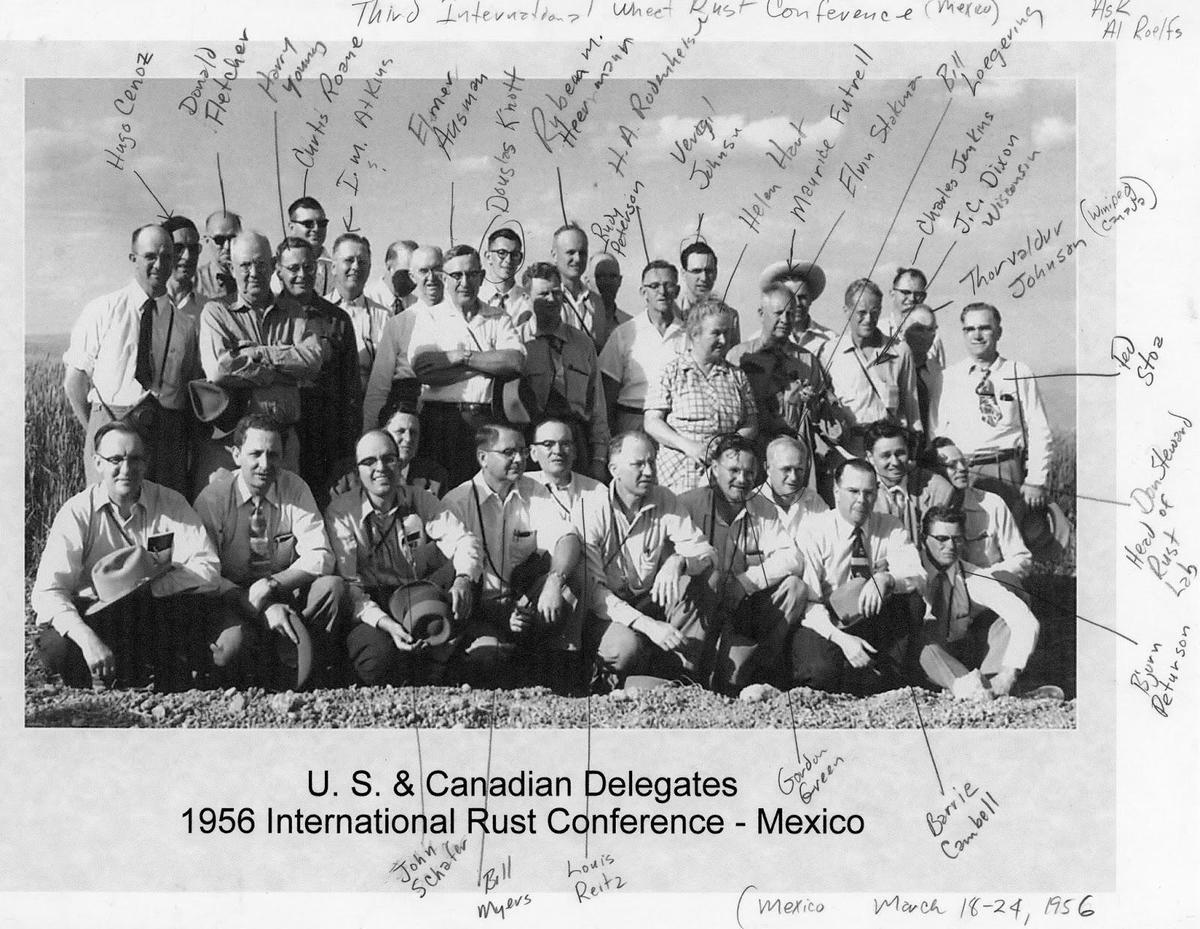New Ally and Weak Stems
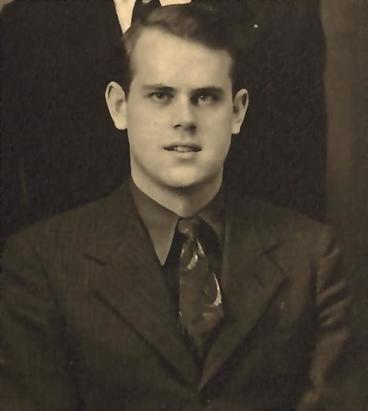
1951 - John Gibler, a new Plant Pathology Ph.D. graduate from Minnesota, joins Borlaug. He replaces Minnesota graduate Joe Rupert who is now in Colombia and Chile heading wheat improvement efforts.
Norman is 3 years ahead of his projected schedule. His wheats Kentana and Yaqui 48 are spreading in Mexico as farmers realize their value. In the Yaqui Valley Don Rodolfo Calles, becomes an advocate for Norman and his young Mexican colleagues as the products of their research enrich the Yaqui Valley.
The use of nitrogen fertilizer at rates of 80 to 120 lbs per acre boosts yields, but heavy grain heads and weak stems cause lodging (plants fall over before harvest). The search begins for wheats with stiff short straw to overcome lodging. Norm grows out the World Wheat Collection looking for short plants with stiff straw but none fit his needs.
Wheat Stem Rust- Ancient Enemy Becomes a New Threat
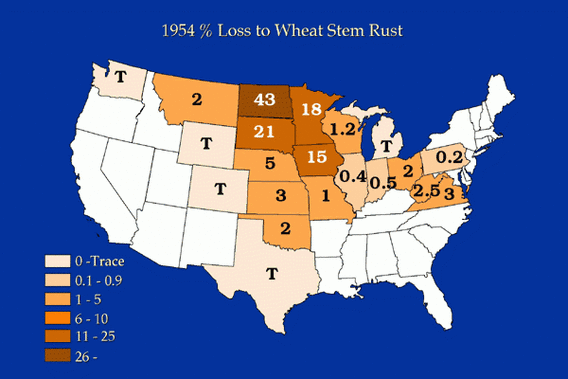
The new pathogenic race, 15B, of the stem rust fungus threatens Borlaug’s program. It is causing epidemics in the United States and almost all of Borlaug’s Mexican lines appear susceptible. There is an urgency to find resistance genes to race 15B of the stem rust fungus.
Harrar Leaves Mexico
Dr. J. G. “Dutch” Harrar who hired Norman and was his mentor leaves Mexico for New York City to take another position in the Rockefeller Foundation. Harrar will eventually become president of the Rockefeller Foundation.
Dwarfing of Wheat-First Inkling
1952 -Norm learns of dwarf wheats from northern Japan, first collected by Gonjiro Inazuka. After World War II a sample of these dwarf wheat seeds were shipped by Samuel Salmon (USDA stationed in Japan) to Orville Vogel a USDA plant breeder at Washington State University. Norman writes to Vogel and asks for a sample of seed. This Japanese dwarf wheat, after many years of hard work, frustration and difficult breeding decisions will become the foundation of the ‘miracle wheats’. The Japanese dwarf wheats will furnish the genes for the semi-dwarfs and dwarfs, and these newly structured plants will out yield all know wheats.
Wheat Quality
Borlaug's advanced breeding line, Lerma 52, proves resistant to race 15B, but it’s flour makes bad bread. His group crosses it with Newthatch, an excellent bread wheat from Minnesota. Now, with good flour producing wheats, from Norman’s program, Mexico’s wheat production soars.
Wheat and Baseball
In 1953, Borlaug struggles to replace his older stem rust disease susceptible wheats with race 15B resistant wheats. He has Lerma 52 which is resistant to race 15B of the stem rust disease, and is ready for massive seed increase.
Vogel sends Japanese dwarf wheat seeds and seeds of his creation, Norin, to Borlaug.
Dr. John Niederhauser and Norm join forces. They introduce Little League Baseball to Mexico, so that their sons can enjoy competitive athletics. They organize the first internationally sanctioned league and co-coach a team in Mexico City. They get corporate sponsors to fund the league and players from impoverished areas.
Troubled Times
In 1954, the political, administrative and other problems within Mexico put the Rockefeller Foundation’s program at risk. A movement is underway that would end in the deportation of Norman Borlaug and others connected with the Rockefeller Foundation. Intervention at the highest levels of the Mexican government by Professor Stakman and others, including Rockefeller Foundation officials and influential farmers like the former Governor of Sonora, Rodolfo Calles in the Yaqui Valley, quell the movement and sort things out. Reorganization efforts begin to achieve what needs to done.
Wheat production is booming, more than 800 Mexican farmers come to the Farmer’s Field Day where the breeding program and wheat growing technology is demonstrated.
Donald Fletcher, another Stakman protege, is heading the “Rust Prevention Association” out of Minneapolis, Minnesota and visits Norm. Fletcher and others propose a multinational approach to solving the race 15B problem. Norm welcomes this idea; he can not defeat 15B and other rust diseases by himself. Fletcher and other of Stakman’s former students and associates help create a collaboration between the governments of Canada, the United States and Mexico. They also form the International Stem Rust Nursery which will be aided by the support of yet another University of Minnesota, Plant Pathology Ph.D., Herman Rodenhiser of the USDA’s Agricultural Research Service.
Surprise Love from Yaqui Valley Farmers
1955 - Don Rodolfo Calles is convinced of Borlaug’s value to the Yaqui Valley. Calles sees the prosperity Borlaug’s efforts have brought. He is, however, appalled by facilities available to Norm and his Mexican colleagues. Calles and farmer cooperatives, grain merchants and bankers ask Norman what facilities he and his Mexican colleagues need. They design a plan for an experiment station and Calles convinces the Legislature in the State of Sonora to help. With additional funds from agricultural cooperatives, banks and Valley businesses they buy 250 acres of flat, irrigated land and tax themselves on wheat produced to add another 600 acres. Norman is astounded by the enlightened self-interest and support of the people of the Yaqui Valley.
Canada and the United States Weigh in
Donald Fletcher and others, working mainly through the The Dominion Rust Laboratory in Winnipeg, Canada and the USDA Cereal Rust Laboratory at the University of Minnesota in Saint Paul, bring many new wheat lines to the Yaqui Valley. They join Borlaug’s battle against race 15B and other rust diseases. They assemble an International Stem Rust Nursery to be planted throughout the world to test breeding materials against all existing pathogenic strains of the stem rust fungus and other rust diseases.
Mexican Farmers Get Norm's Seeds
Norm finds new and creative ways of getting his wheat seeds into the hands and fields of Mexican farmers. Mexican farmers experience great gains using Borlaug’s wheats and technology.
Baseball
Little League Baseball in Mexico catches on throughout Mexico.
A Year of Momentum
1956 - Mexico produces enough wheat to be self-sufficient. Borlaug’s fame spreads throughout Mexico.
The international effort to defeat stem rust gains momentum. Norm attends the 2nd American Stem Rust Conference in Manitoba, Canada.

Evangelina Villegas, hired by Harrar, finishes her BS degree in Biochemistry. She works with Borlaug to determine the baking quality of the flour from his wheats. Milling and baking qualities will determine all future wheat releases, nothing will be released without Evangelina’s approval. Her laboratory and importance will be recognized worldwide. In the year 2000 she will be the first woman to receive The World Food Prize.
Norman Borlaug, John Gibler and Alfredo Campos make their first crosses of their Mexican wheats with the dwarf Japanese wheat.
The Borlaug/Niederhauser coached “Aguilas”, in the Aztec League, win 18 baseball games.
Reluctant Dwarfs
1957 - The initial crosses with the dwarf Japanese wheats are not encouraging. Dwarfism is caused by a complex of recessive genes, many of which are linked to undesirable traits. Nevertheless, Norman will make dwarfing wheat his priority for the next decade, some say he is obsessive about dwarfism. He wants to design a short, stiff strawed plant to hold up massive, plump grain heads.
Bright Spots
Norman’s protege, Ignacio ‘Nacho’ Narvaez, returns to the breeding program after receiving his Ph.D. from Purdue University. Dr. Narvaez will later play a huge role in the Green Revolution in Pakistan and India.
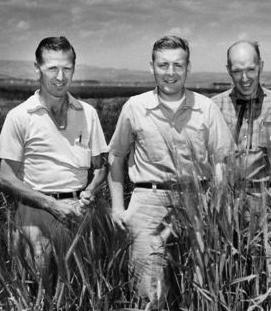
Donald Fletcher of the Minnesota based Rust Prevention Association hires another Stakman protege, Dr. Eugene Hayden, to assist him. They help guide the international collaboration, between Canada, Mexico and the United States to battle race 15B of the stem rust fungus and other rust diseases. Fletcher and Hayden will become life-long friends and supporters of Norman Borlaug and his efforts. This collaboration now has plant pathologists and wheat breeders from the provinces of Alberta, Saskatchewan and Manitoba in Canada, and the states of Minnesota, Wisconsin, North and South Dakota, Indiana and Montana. It has the support of another Minnesota Plant Pathology Ph.D. graduate, Dr. Herman A. ‘Rody’ Rodenhiser of the Field Crops Research Branch, Agricultural Research Service of the USDA. Dr. Rodenhiser is instrumental in USDA cooperation and collaboration in all aspects of the international collaboration in the battle against race 15B of wheat stem rust and other rust diseases for the next decade and more.
More Baseball
A Little League team from Monterrey, Mexico travels to Pennsylvania and wins the Little League World Series. Borlaug’s schedule doesn’t permit him attend, but co-founder Dr. John Niederhauser goes.
Success of the 'Bird Boys'
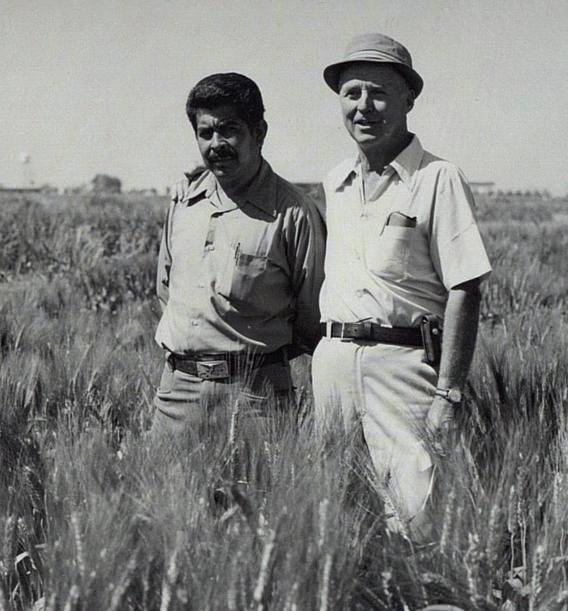
1958 - Some ‘Bird Boys’, given the chance, acquire great skill and achieve Master Technician status in the wheat breeding program. Norman demands they be paid the same as college graduates. Some Bird Boys will go to high school and college. One Bird Boy, Reyes Vega, will create a new protocol for wheat breeding, and another, Arturo Hernandez will go on to graduate work and be awarded a Ph.D. from the University of Minnesota.
Many other young Mexican scientists from Agricultural Colleges have, over the years, been selected to go to the University of Minnesota and other Land Grant Universities. Several have returned to Mexico ready to assume positions in the program.
Norm’s skill and genius at leading teams of young scientists has produced a miracle for Mexico’s wheat production. In doing so he has produced many Mexican “wheat apostles”, however, his disdain for report writing, sticking to budgets and the paperwork and flow associated with administration becomes legendary. More than once Director Harrar considers firing Norman, but always relents.
Dr. Glenn Anderson
Norm meets Dr. Glenn Anderson, a plant scientist from Agriculture Canada. They mesh almost immediately, and Anderson will play a large role in Norman’s future.
Losses and Gains
There is a massive flood in the Yaqui Valley that causes stored seed to be lost and two good, loyal men to drown trying to save those seeds.
Norm is impressed by the drive and ambition of the underprivileged boys playing on the Little League Baseball team he is coaching in the Aztec League. The shortstop Raul Castro wants to learn English. Norman arranges for him to spend the summer in Norm’s sister’s home in Cresco, Iowa to help young Raul with his English.
Mission Accomplished?
1959 - Wheat production has risen 14-fold since Borlaug arrived in 1944, and now more than half of that yield comes from the Yaqui Valley. Norm’s ideas and efforts are validated.
Norman receives the Outstanding Achievement Award from the University of Minnesota. It is one of the first in a tidal wave of awards and honors that will come his way for the next 50 years.
The Rockefeller Foundation is about to close the Mexican program and turn it over to the Mexican Institute for Agricultural Research (INIA). Norman is essentially out of a job and names his Mexican successor and his protege Dr. Ignacio Narvaez to head the program. Narvaez wants Norman to remain as a consultant and collaborator.
The Rockefeller Foundation wants to begin a new Inter-American Food Crop Improvement Program headquartered in Mexico but operating in South American countries. Norman would head the wheat program, Wellhausen the maize program and Niederhauser the potato program.
In preparation for this new program Norman is sent on an exhausting survey mission to Argentina, Brazil, Bolivia, Peru, Ecuador and Chile to see where the program would be most helpful.
The Race 15B Battles and the Promise of the Dwarfs
The battle against race 15B of the stem rust fungus is going well. The resistance sources from the collaborators Elvin Stakman (Minnesota) and Edgar McFadden (South Dakota) are proving very useful.
Some of the thousands of dwarf wheat crosses are showing promise, especially lines of semi-dwarfs, but they need yet more breeding work.
Unemployment Looms, Another Survey Mission, A Suggestion
1960 - Norman contemplates his future and sees that in Mexico he would spend his time as a program administrator - a task he abhors. He tentatively accepts an offer from United Fruit Company to breed disease resistant bananas in Honduras. His wife Margaret and family are in favor. The offer stalls when Norman insists on hiring two Mexican master plant breeding technicians to assist him.
Borlaug is saddened by the passing of Mrs. Cathy Jones. She was the last of the Yankee pioneer farmers who established the Yaqui Valley and she was the first person to befriend him.
It is a confusing time for Norman Borlaug. He is at the pinnacle of one career and is now being forced to consider another. His friend from his Ph.D. program graduate days at Minnesota, Dr .Al Moseman, now in the Rockefeller Foundation Headquarters, recommends him to represent the Foundation as a survey team member of the United Nation’s Food and Agricultural Organization (FAO). The FAO team is to assess wheat and barley programs in the Near and Middle East. Borlaug is “the man from Rockefeller” as the team meets in Rome. They travel through Algeria, Libya, Egypt, Jordan, Lebanon, Cyprus, Afghanistan, Pakistan and India. Norm sees the “brothers and sisters” of his Mexican wheats growing in experimental plots in these countries. They have traveled far and are a tribute to his and his Mexican team’s revolutionary breeding.
Norman sees the same things he saw in 1944 in Mexico. Impoverished soils, primitive agriculture, poverty, sickness, human misery, lack of rural education, poor sanitation, hopelessness, solemn children and worst of all, lack of brave applied scientists and massive societal indifference. Back in Rome the task of changing north Africa and the mid-East seems overwhelming; for days he experiences mental paralysis. Finally he decides that there must be a new beginning in these countries. He believes a duplication of the experiences the young Mexicans went through could be used to train, educate and motivate young scientists from North Africa and the Asian subcontinent so they return home and carry on. He proposes a hands-on apprenticeship program be established in Mexico. There, he and young Mexican scientists would do the basic training in plant genetics and breeding, agronomy, irrigation, plant pathology, entomology and cereal technology.
As a practical matter trainees would learn, hands on, how to level fields, how to layout sample plots, sow wheat seed and apply water and fertilizer. They would also see the results of their efforts because their traineeships would be for an extended period. He writes his FAO report and includes establishment of a Spring Wheat Yield Nursery to be widely grown in North Africa and in the Middle East as well as in Latin American countries, Canada, Australia and the United States. The Spring Wheat Yield Nurseries serve several purposes, but mainly as in-country demonstrations of what can be achieved.
